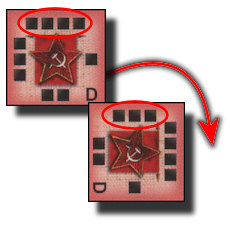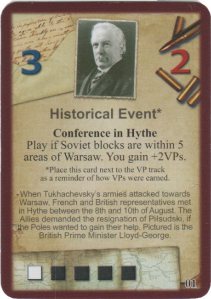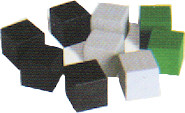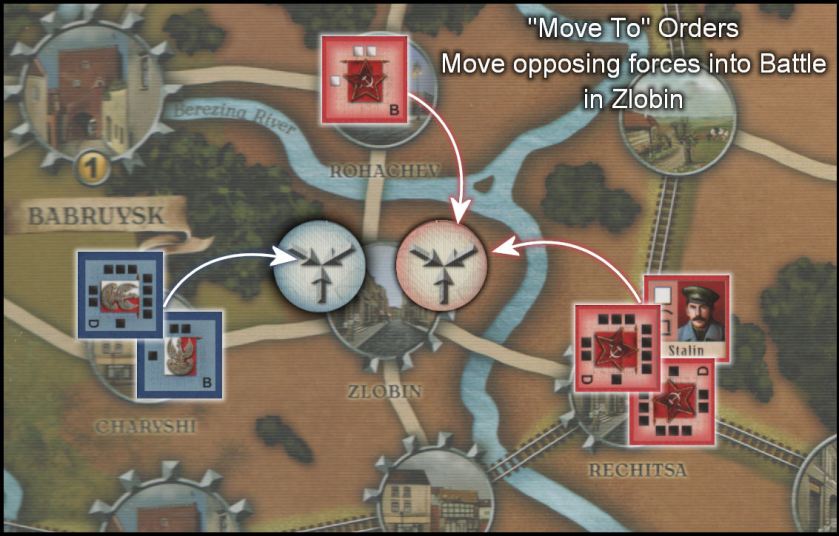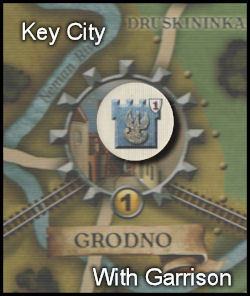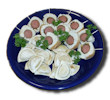By Harvey Mossman
A Gourmet Achievement for the Discriminating Palate
As a young child, I watched my grandmother cook for all the holiday family get-togethers. She told me that the secret of a good chef was to use the best ingredients and keep each in balance with the other. Academy Games must have had this in mind when they took a prior recipe, the Eagle and the Star designed by Robert Zak, added a touch of this and pinch of that and, as Chef Emril would say, “Bam!” produced a gourmet meal.
Strike of the Eagle is a game to be savored. From the moment you open the sturdy box revealing the beautifully illustrated mounted map, you realize this game was produced with epicurean care. The map shows stylized cities each connected by paths or railroads. There is a player’s aid sheet, two decks of well-illustrated cards (one each for the Polish and Soviet players) , a card with tracks for Victory Points and Initiative and finally, clearly illustrated sticker labels for the blocks which take the place of the usual cardboard counters. Yes, some assembly is required. The rules are printed on magazine quality glossy paper and are extremely clear and profusely illustrated. They can be digested in less than 30 minutes. Professional chefs know that an exquisite meal can be ruined if the presentation is poor. Academy Games gets extremely high marks in this regard.
The Recipe
As for gameplay, the designers have taken tried-and-true ingredients and blended them to create a tension packed, and decision filled, challenging delicacy. Let’s examine their recipe a little closer.
Fog of war is a huge element of this design. Units are represented by blocks that stand upright facing the player with unit type and strength hidden from your opponent. Additionally, step loss reduction is secretly administered by turning each block 90° for each loss suffered. Therefore, you are never quite sure of the enemy forces combat potential. Furthermore, units are given secret orders by placing order markers face down on the playing board. Orders include Move To, Move Out, Force March To, Force March Out, Withdraw, Defend, Reorganize, Recon and Rail Move. The player with the initiative decides who places the first order which can be a big advantage as it may give imprecise hints as to your opponent’s operational plans for the turn. However, with facedown orders there is plenty of room for bluff and misdirection. This is one of my favorite aspects of the game.
In brief, Forced March Out and Move Out orders are placed on a space with friendly units and activate all units in the space to march out in any direction. Infantry move 1 space, cavalry moves 2 spaces and a Forced March Order gives each unit type an additional space to move. Move To and Forced Marches To orders are placed on any space with the requirement that units following these orders end their movement in the target space. Withdrawal orders lets you retreat if your units are attacked at the cost of one strength point lost. Defend orders allow friendly units to ignore the first loss in combat and negates one enemy flanking attack. Units gain one strength point under a Reorganize order but they may not move and fight at half combat strength rounded down if attacked. The Rail Transport order allows units to move along a friendly rail line up to eight spaces. Finally, the Recon order is a mandatory order that must be placed in each operations phase and allows you to look at enemy unit strengths. However, since it can be placed within three hexes of a friendly unit, it is sometimes best utilized as a crafty misdirection by placing it on a friendly or unoccupied space to make your opponents think that some other order will be executed there.
While Fog of War is the sauté to whet the appetite of gamers, the meat of the game is the cards. I cannot say that Strike of the Eagle is card driven a la We the People because players can take actions without the use of cards, but it is intensively card dependent. You simply will not accomplish anything of great value without utilizing cards.
A player can have seven cards in his hand. Each card can be utilized in one of four different ways. In the upper left-hand corner is the Order Modifier which gives the player additional orders beyond the 2 he gets at the start of each operation phase. This can be critical because one of his 2 orders will be the mandatory Recon order, leaving him only one order to move or defend. A player who does not utilize the Order Modifier will most likely cede the operational initiative to his opponent for that phase.
In the upper right-hand corner of the card there is a red Combat Modifier. This value is added to the player’s combat strength to determine the losses that he inflicts on his opponent. In the middle of each card is text which represents historical events, battle effects or battlefield events. Finally, at the bottom of each card are a number of squares representing Reinforcement Cubes which can be accumulated over the course of the turn to be cashed in in the reinforcement phase to form new units or augment depleted units.
Proper use of the cards is one of the most tense and challenging aspects of the game. Cards with higher Order Modifiers tend to have high Combat Modifiers, highly effective events and a multitude of reinforcement cubes. Deciding the priorities for using the card is of utmost importance to effective gameplay. Is play of the event more important than operational maneuverability? Have you taken such significant losses that getting reinforcement cubes are paramount? Do you save this card for an important battle to take advantage of its high Combat Modifier? There are no easy answers to these questions which makes this game so exciting.
The Ingredients
As I now have your digestive juices flowing let’s run through a typical turn so that you can see how all these wonderful ingredients has been combined into a gourmet meal. The turn is divided into five operational phases. Each phase starts with players replenishing their hand by drawing new cards from their respective decks. At the beginning of the first Operation Phase each player draws six new cards. Thereafter he gets two cards on phases two through four. A player can have a maximum of seven cards and must discard down to that limit by the end of this phase.
Following the Replenish Cards Phase is the Initiative Phase. The game map is divided horizontally into northern and southern fronts for each player’s Army. The initiative is determined for each front. The player with the highest initiative on his front decides who places the first order during each operation phase and who executes each order type first. This is critically important.
Once the first player is decided, it alternates back and forth until all orders are placed. Allowing your opponent to place orders first may give you a hint as to where he might be making an offensive thrust. Even more critical is the ability to decide whether you or your opponent executes each type of order first. Sometimes you want to move before your opponent to get to a critical city space before he does. Other times you would prefer that he tips his hand so that you may best react to it. This adds another aspect requiring tough decision making and problem solving. Initiative is increased by certain event cards and by winning battles. However, the higher your initiative the more difficult it becomes to raise the initiative further. You must inflict more strength point losses than your current initiative level to increase your initiative. This wonderfully simulates how the friction of war impedes the buildup of your momentum. Any lost battle will reduce the initiative but the initiative level cannot increase or decrease by more than one point for each battle.
The players now have the option to play a card face down to garner additional orders, trigger a historical event or accumulate reinforcement cubes. It is not mandatory to play a card at this point. After historical events have been resolved, the number of orders increased and reinforcement cubes distributed, players then place orders. The map is divided into a Northern and Southern front for each player so that the game can accommodate up to four players. The player with the initiative on each front decides who will place their orders first. In certain circumstances leaders can then contribute additional orders if activated. Next orders are executed in a strict sequence. Force March orders are executed first. As orders are revealed they are executed with one player executing all of his forced March orders followed by the other. Next, all recon orders are executed followed by movement orders then withdrawal orders.
If opposing units now occupy the same space, combat ensues unless the defending units are under a Withdrawal order. If attacking units entered the space from more than one direction, they gain a Flanking Bonus which reduces the defenders combat value by two strength points for each additional path of entry above the first. The Flanking Bonus can be mitigated by having a Defend order which allows the defender to ignore the first strength point loss in battle and negate one enemy Flanking Bonus. Certain cities on the map have fortifications. If all attacking units are coming through the fortifications symbols, these act like an additional Defend order negating one flanking bonus and allowing the defender to ignore one strength point of loss. Finally, if the defender has Supporting Units moving into the battle space then, for each path that these supporting units enter, one Flank Bonus is negated.
Combat is now resolved. Each player may play a Battle Card which often adds or subtracts strength points or losses to the attacker or defender. Next, the players must play a combat modifier card. If played from his hand the Combat Modifier Value is augmented by one. Otherwise, the player uses the face value of the Combat Modifier of a card drawn from his deck. Note that the battle card and the Combat Modifier card are played before combat unit strengths are revealed. Therefore players don’t know how strong his opponent’s forces are before making decision on how to play his cards. Now unit strengths are revealed and totaled taking into account modifiers for fortifications, Defend orders, Flanking Bonuses, Battle Card effects and Combat Modifiers.
There are no dice utilized in combat resolution. Each player’s total combat strength determines how many losses he inflicts on the opponent. A value of 4-6 inflicts one loss, 7-9 inflicts 2 losses, 10-12 inflicts 3 losses, 13-17 inflicts 4 losses, 18 or more inflicts 5 losses. Losses may be reduced by previous played Battle Card or the play of Battle Event cards which occurs immediately after losses are determined. The player who suffers the most actual losses after modification from Battle Cards and Battle Events must retreat. Ties cause the attacker to retreat. Successful attackers must move at least one unit into the captured space. Others can return to the spaces from which they came. Losers must retreat towards a friendly Key city.
After combat, Reorganization orders are executed followed by Rail Movement orders. Then supply is judged. Infantry units must be within three spaces of a friendly Key city that can trace supply back to a supply source which is Warsaw for the Polish and the Soviet Eastern links for the Russians. Cavalry can trace five spaces. Units out of supply are marked by an out of supply marker and suffer one strength point of attrition.
There are five operations phases to each turn and when all are complete, the reinforcement phase begins. In this phase players get additional reinforcement cubes from cities they control and add that to any reinforcement cubes they collected by play of cards during the operation phase. Friendly units can now absorb or detach strength points to consolidate units, place Garrison markers on Key cities they occupy, expend reinforcement cubes to augment one unit one strength point in spaces that are adjacent to the enemy (frontline units), freely augment friendly units not adjacent to the enemy and finally, spend 2 reinforcement cubes to build a new one strength unit.
The victory conditions are then checked and a new turn begins. Victory points are gained by capturing Key cities or play of certain Historical Events. Additionally, eliminating out of supply units or destroying units who lack a legal retreat gives one victory point per unit destroyed. A victory point is gained by winning Great Victories if you inflict at least 4 real losses to your opponent in a battle. There is a victory point track which shows the victory point advantage one player has over the other. If a player’s advantage reaches 15 points he wins the game.
The Meal
So how does the game play? We assembled 4 players and jumped right into the full campaign scenario. On the Northern front the Poles must play cautiously and pick spots carefully to attack. The Soviet forces are at least their equal and Soviet reinforcements rapidly accumulate on the Northern front. The situation is reversed in the South. The Southern front Poles are stronger and can launch an offensive that pushes the Soviets back towards the key city of Kiev. The Southern front Soviet commander must use Withdrawal and Defend orders carefully so that he can keep his line intact while using his cards to accumulate reinforcement cubes. He does get a significant reinforcement in the Soviet Cavalry Corps which consists of 4 full strength cavalry divisions and 1 cavalry brigade. However, the entry of these units is somewhat random based upon pulling the correct Combat Modifier value from the deck until they automatically come in on the second operation phase of Turn 2.
It is important that players pick specific axis of attack since broad front offensives often result in significant losses and little movement towards one’s objectives. The key decisions are whether to play your cards for additional orders, historical events or reinforcements. Typically, players will wait until the fourth and fifth operation phase to play for reinforcement cubes since by this time units are spent and hand sizes depleted. This wonderfully simulates the exhaustion of offensive momentum. A player also has to be careful lest his opponent achieve a large advantage in numbers of orders during a given operation phase. Operational pacing and balance is paramount to achieving your objectives or successfully defending. Each operation phase we found that we were constantly challenged how best to utilize a given card. Hand management is critical because a player going into battle without Battle Cards is severely handicapped.
By the mid-game, Soviet reinforcements tend to swing the momentum and the spent Polish player must make a decision when to cut and run back to the Curzon defensive line. While the Soviets give chase, the Polish player must accumulate reinforcements and prepare to counterattack. At this point in the game, my Polish compatriot and I had bitten our fingernails down to the cuticle. As the Soviet logistical tail lengthens, the Polish player has a chance to counterattack. Once again multiple frontal attacks will achieve little. We used brilliant misdirection by order placement to punch a hole in the Soviet lines causing them to reel back. Although the game ended with the Soviet victory it was a “near run thing”.
The game uses simple straightforward concepts that we have all encountered in other games. Initially, there was some confusion about the interpretation of MOVE TO and FORCE MARCH TO orders. The rules seem to indicate a strict interpretation whereby units executing these orders must end up in the targeted city. However one of the rules illustrations suggested that these orders could be used simply to have units move towards the objective even if they could never actually reach it. This created a lot of confusion as to what defined moving towards the objective. The designers rapidly responded that the strict interpretation was indeed what was intended. In summary, MOVE TO and FORCE MARCH TO orders must be executable at the time of placement. During Orders Execution they are voided if no unit could possibly reach the targeted space because of intervening enemy units. Any unit executing a MOVE TO or FORCE MARCH TO order must end in the targeted space.
Conclusion
We have played this game many times now with various players and different strategies. Each time the game played differently yet remained exciting and challenging for all. My one concern is that Historical Events tend to be underpowered and situational making it less likely that players will forego the additional orders or reinforcement cubes on the card to play the Historical Event. This is only a very minor caveat to an otherwise exceptional game.
It is rare that a game so delights the senses and stimulates the appetite for more. I’ve played this game several times now and remain un-satiated. While the full campaign game can take 8 to 12 hours to complete, there are smaller scenarios to whet your appetite. However, Academy Games has served up a truly gourmet meal; one that should be leisurely enjoyed and truly savored. Bon appétit!



